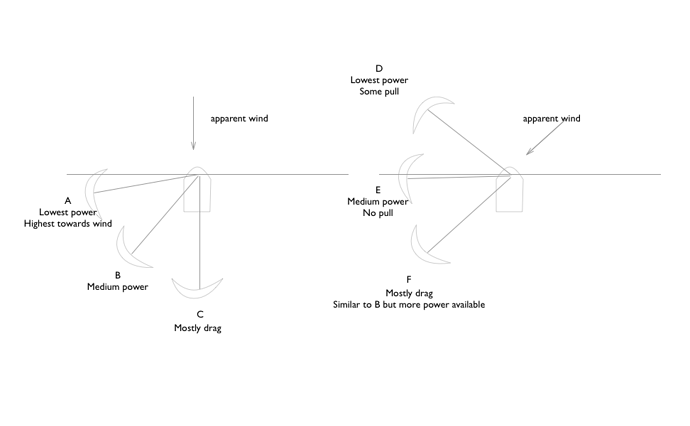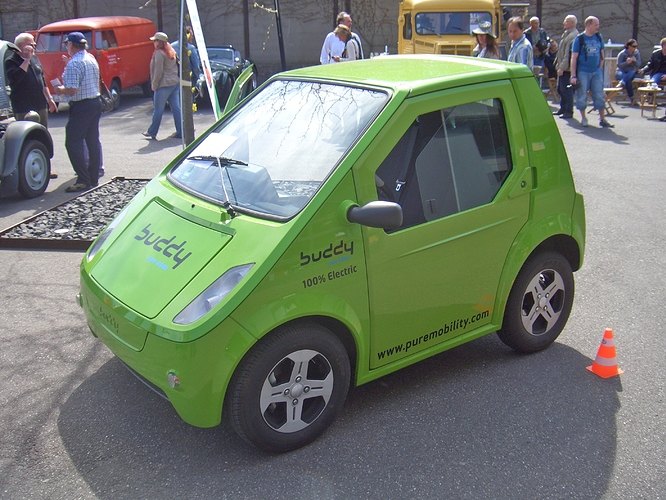Haven’t noticed the update. Nice plots.
Why is there no energy production downwind? There would be energy production and fuel savings.
A fixed course ship would be able to benefit from kite power at least at the same angles as a sailboat.
(When using fancy things like dynamic soaring like seabirds, maybe even more)
A augmented ship will not have a keel though, which becomes relevant with large kites relative to the ship.
[…continuation]
6. Becomes irrelevant when using auxillary kite power.
7. The submarine point is really stuid. Hydro drag will always be much larger than aero drag regardless of the hull shape. Yes, kites will need to be large to pull a whole ship and they will need to sweep a large area. But any auxillary kite power is usefull, too.
8. Fuel use depends on the size of the system. A truck is worse than a barge is worse than a train. However we don’t operate giant trains with 15TEU.^^ So yes- ships are fuel efficient.
Compared to trucks or trains they do lend themselves very well to kites. Much better wind conditions, no obstacles, fixed course, low travelling speed, long travels. The energy demand for auxillary ship propulsion on a large vessel exceeds any power generated by awes to date. So once a system is commercialized and a contract with a large vessel operator is made the system can be scaled and or multiplied very fast.
9. 25knots ~12m/s. That’s ship speed. No relative wind. Here he’s way too optimistic. o.O
10. I assume useful wind direction and strength is much more stable high up on the ocean.
11. These are technical difficulties that can be overcome. That’s what I wanted to address with my startup. Kites are operated by a seperate company which charges just a portion of the fuel savings.
12. CO2 emissions are an unpriced negative externality. If the world ever does agree to price it, oil will be very expensive. However unfortunately I don’t see this coming in the next 20 years.
To read the figure I did some simplifications. The tether must always be normal to the path of the vessel. This is why you cant produce power at low speeds. You could produce power downwind, I didnt include that in my equations because:
The vessel will be travelling at 12 m/s regardless of where the power comes from. This is a requirement to be in the cargo business. Any long vessel travelling this fast will be able to withstand a bit of sideways force, even more is a keel is installed. So that just depends on how large a force you design the vessel to withstand. If you want 100% kite, the keel probably needs to be quite large, but for 20% perhaps no keel is necessary.
As the vessel is travelling so fast, there is no point in calculating what happens if wind is in same direction as vessel path. The wind is almost never high enough for this (eg, 22 m/s same direction as vessel for 10 m/s apparent wind from aft), so this is a very good approximation.
In real life wind is mostly quite weak, so the apparent wind will almost always be facing some angle from front to aft. In this case the kite must face 90 degrees to the path in order to not create a large breaking force against the vessel’s speed.
Yes, you could point the kite lines forward to get some free power, the tether pulling the vessel. If you do this, the harvested power will be less, so if you want to do this, it depends on the power conversion efficiency from kite to propeller. The answer to this will probably be “yes”, you want to go a bit upwind with the kite, but anyways this will, energy wise, just be seen as an additional loss.
I’m not sure if the graphic is correct, but I have studied it closely and I think it could be correct.
For container ships you would have to generate a massive 50 MW+ energy. No question a really large kite is necessary. The dimension of the keel for such a vessel I haven’t really considered yet. The problem may be alleviated by producing power on smaller kiteships and then transferring the energy in transit, rather than placing the AWE rig on the cargo ship. Look at the picture - there’s no really good place to put a kite anyways
… at the surface. Live Wind | SailFlow [edit: miles/h. Damn that’s slow
Windy: Wind map & weather forecast here one can choose m/s]
Does anyone know what the situation higher up is? We won’t be harvesting jet-streams at 150 m/s, but higher up will certainly be better.
I have not completely understood your considerations, but I don’t think the force on the ship is properly accounted for. Any force on the ship opposing the direction of travel is a loss. In other words: The difference between wind and apparent wind is generated by the ship engines. Any utilization of that results in an energy loss.
I think a figure explains it best.
In A, B and C you might still be able to generate power, if you reel out the kite faster than the vessel speed. Having the wind from front to aft at zero angle will make it very difficult to produce power. As my figure is for a rotating AWE rig, reeling out was not accounted for, and all these probably create more breaking force than what you are able to counteract with the propeller.
In D, E, F, you are able to put the kite to pull the ship (D), but in this position, the kite is at the egde of the window generating little power.
At E you are generating the maximum power without causing any drag. This is the optimum placement of the kite if there are no conversion losses kite to propeller thrust.
Again, only the wind coming from front to aft is interesting due to the high vessel speed. The other directions are possible, but will not occur frequently enough to have an impact on this analysis
Thank you for the illustrations an explanations.
We should clearly distinct between:
- Fixed course auxillary traction (skysails)
- Fixed course auxillary power gen and traction*
- Kite traction (kiteboarding, sailing)
- Pure power gen ship moving
- Pure power gen ship/platform static
*What your image refers to
*Plenty of electricity nee on ship, especially with cooled containers.
It doesn’t matter if power is converted to electricity or otherwise, or just converted to a pull. If you do generate electricity, you have options for storage and you’ll get a higher power output from the kite, but at a cost of more components and power losses in the conversion.
12 Knots maybe Not 12m/s
Sorry for posting the Maersk wikipedia link, that shows cruise speeds at approx 12 knots. I was originally looking at this link:
https://www.quora.com/Merchant-Navy-What-is-the-average-speed-of-a-ship
The latter states 12 m/s speed for container ships.
I think 12 m/s might be correct as ship speed is mostly dependent on hull length and these ships are huge. I’d be happy if someone more knowledgeable would chip in their opinion on this though
I found the same number. But also: Modern cargo ships slow to the speed of the sailing clippers | Travel and transport | The Guardian
So lower speeds are not ruled out, changing the equation.
This would be very nice for AWE, if ships travelled only 6 m/s.
When trying to improve on CO2 emmissions, I think you should not factor inn larger changes like this. Cargo ships travel fast because the cargo itself has value and fast delivery is a competitive advantage for cargo freighters. Some customers will accept slower transit speeds to save enissions or $, but most probably these are the exceptions to the rule.
I think the parallel to electric cars is pretty descriptive. People didnt start buying electric cars until the cars were as big as petrol cars, had a comparable range and otherwise looked like a normal car. People’s resistance to change also needed them to be cheaper. Small, cheap, encironmentally sound cars have been in the market for a long time, but people didnt want to drive a tin can with only two seats.
Your ability to address the problem is only going to be as good as the quality of your analysis. Anyone genuinely interested in the problem should try to understand the market first. That’s a marathon, not a sprint.
Here’s a start:
I’d like to see a graph of this over time, and per shipping route.
So many dimensions.
I think it is much easier to just pick out a small fraction, with good conditions for awes, of the market and focus on that. If there is a subset identified, for example a certain class of ship on a certain route, it is likely that that submarket will be large enough to scale within for many years.
https://www.reddit.com/r/Futurology/comments/a35x48/maersk_worlds_largest_container_shipping_group/
Right. That’s a more interesting problem anyway. Think long enough on that and a viable business plan might even come out of it. Run the business long enough and you may even have the resources and expertise to do the other thing.
You could brainstorm on the ideal conditions and possible current markets. And do a separate analysis for each possible market.
Who buys (sail)boats now? What are high margin businesses?
A search for “Sail Cargo Service” shows small scale companies exist.
e.g. https://www.treshombres.eu/story
However, Best designs will fit with standard dockside cargo handling infrastructure otherwise implementation would be unscalable.
Just dumping this here:
Kite Dynamics for Ship Propulsion
George Michael Dadd
A dissertation submitted for the degree of
Doctor of Engineering
at the University of Southampton
Tutors Dr D. Hudson, Prof. A. Shenoi
February 2012
Draft printed on February 26, 2013
Some discussion in the above topic. Here for example.
http://www.dcss.org/speedsl/Trans_Sailcraft.html
This read by Dave Culp also has some interesting thoughts on the subject
Peter lynn is producing kite at weifang keichuan kite. Although they are great kite, they are costly.
Weifang is the capital of kite fabric and there is others manufacture where you can get good product at a better price.
Kite duration is an important matter. It shall be taken into account that things are different if you flight frontwind or crosswind. in first case, forces are much lower and constant so that kite duration shall be largely enhanced. To be estimate on long run of course.

